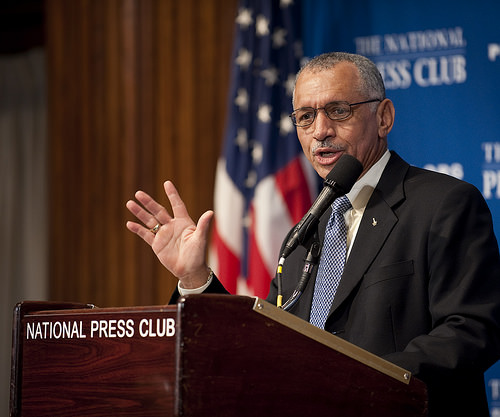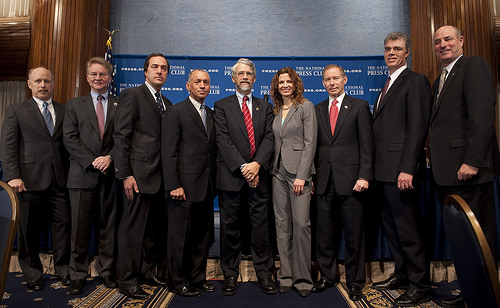[/caption]
NASA Administrator Charlie Bolden introduced today five commercial space companies that NASA will use to support transport of crew to and from low Earth orbit as part of the Commercial Crew Development program. The firms were selected in an open competition for $50 million in funds from the American Recovery and Reinvestment Act of 2009. During the event, Bolden countered the criticism of NASA’s new plan proposed by President Obama. “I respectfully disagree if you think we are abandoning human spaceflight. I think we’ll get there quicker. This is a fundamental re-baselining and a new ways of doing business to develop a program that is truly sustainable for the long term,” Bolden said. “This is a roadmap to even more historic achievements… We are not abandoning human space flight by any stretch of the imagination. We are on a new course, but human space flight is in our DNA.”
Several of the companies already do business with NASA, such as Boeing and United Launch Alliance – a coalition between Lockheed and Boeing.
Boeing will receive $18 million to work on a seven-person capsule that may launch on a medium-class expendable launch vehicle. Bruster Shaw from Boeing said “We’ve been in this game a long time and we have a vested interest in the International Space Station. We want to see ISS live up to its potential by having a robust logistics for the delivery of cargo and crew.”
Paragon Space Development Corporation will receive $1.4 million for life support systems, primarily an “air revitalization” system. President and founder Jane Poynter said, “We have developed and tested an array of technologies to use in a whole array of settings: on the ISS, the Moon, Mars. Air revitalization is the first of its kind, and will be a turnkey system to be used on any spacecraft on an array missions. We are deeply committed to the development of space for human exploration.”

Sierra Nevada Corporation will receive $20 million for the development of their “Dream Chaser,” a seven-person crew vehicle based on the Hl-20 runway landing, heavy lifting body concept (looks similar to the canceled Crew Return Vehicle for the ISS). Mark Sirangelo, Chairmen and Vice President of Sierra Nevada said, “Space is hard, it takes a lot of cooperation and teamwork. We have come through an unfunded space agreement with NASA, and have advanced our program to be very successful. We are looking forward to moving to the next level.”
The United Launch Alliance will receive $6.7 million for an emergency detection system for that will allow crewed capsules to launch on the Atlas and Delta rockets. Mike Gass, ULA President and CEO said “ULA has been supporting the nation with over 50 years of experience. Atlas and Delta will be used to support commercial crew in the future, and it’s all about crew safety, and we’ll provide a synergistic system to provide safe support.”
Blue Origin will receive $3.7 million for a new type of crew escape system. Robert Millman from Blue origin said, “We are dedicated to creating technology for enduring human presence in space. We are developing a “pusher” escape system, with an escape motor at back of capsule to avoid a jettison event.” They are also working on a composite pressure vessel to improve the durability for a conventional crew cabin.

Also in attendance at the press conference were the companies that already have contracts with NASA through the COTS program, Space Exploration Technologies (SpaceX)and Orbital Sciences Corp. David Thompson, CEO of Orbital applauded the new direction for NASA. “At their first turn at bat the Obama administration hit it out of the park. This new approach represents a dramatic change, and is consistent with what we’ve seen in this country and around the world, where there is an increased reliance on an ever-more reliable private sector. It seems this is the right time and direction for the agency to take in this new era, and I’m confident the private sector is up for new challenges”
Former astronaut Ken Bowersox with SpaceX said, “One of the most exciting thing about the budget is that it acknowledges one of the biggest barriers to exploring space: how to pay for it. It is going to be great to watch what happens when we blend the skills available in government with flexibility of the private sector.”
Top photo notation: From left, Ken Bowersox, VP Astronaut Safety, SpaceX, David Thompson, CEO, Orbital Science Corporation, Mark Sirangelo, VP and Chair, SNC Space Systems Board, Sierra Nevada Corp., NASA Administrator Charles Bolden, Assistant to the President for Science and Technology and Director of the White House Office of Science and Technology Policy Dr. John P. Holdren, Jane Poynter, President and Chair, Paragon Space Development Corp., Brewster Shaw, VP and General Manager, NASA Systems, Boeing, Robert Millman of Blue Origin, and, Mike Gass, President and Chief Executive, United Space Alliance.

